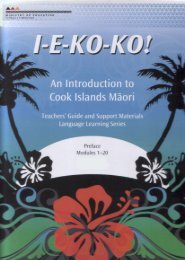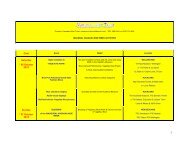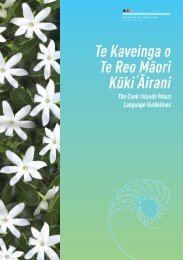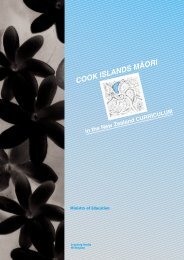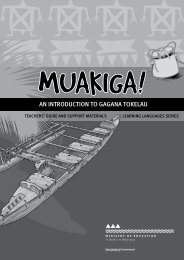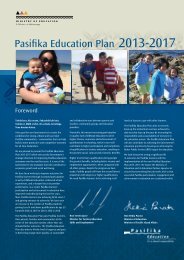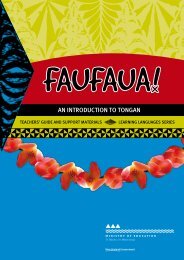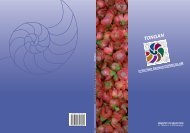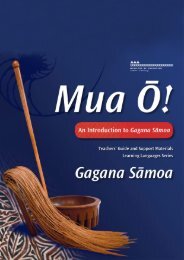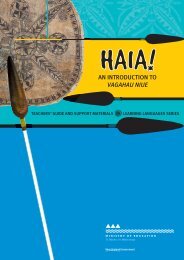Ta'iala mo le Gagana SÄmoa - Pasifika Education Community
Ta'iala mo le Gagana SÄmoa - Pasifika Education Community
Ta'iala mo le Gagana SÄmoa - Pasifika Education Community
Create successful ePaper yourself
Turn your PDF publications into a flip-book with our unique Google optimized e-Paper software.
Vāega 1: ‘O ni fa‘ata‘ita‘iga i <strong>le</strong> fa‘atinoga o a‘oa‘oga ma iloilogaLevel 1: Suggested <strong>le</strong>arning and assessment activitiesNot all of the following activities are suitab<strong>le</strong> for every age group. Teachers will se<strong>le</strong>ct those thatare appropriate, adjust a particular activity to suit the needs of their students, or make up their ownactivity appropriate to the objectives to be met. Some activities specific to cultural <strong>le</strong>arning are listedabove, under the heading Suggested aspects of fa‘asā<strong>mo</strong>a. It is also important to acknow<strong>le</strong>dge thecultural context present in all genuinely communicative activities so that students are supported asthey acquire the linguistic and the cultural know<strong>le</strong>dge and skills they need to communicate confidentlyand effectively with other speakers of gagana Sā<strong>mo</strong>a.<strong>Gagana</strong> fa‘alogo ma <strong>le</strong> tautalaOral language: Listening and speakingStudents could be <strong>le</strong>arning through:• distinguishing between the sounds of gagana Sā<strong>mo</strong>a and those of other language(s);• listening to short texts and identifying certain sounds, words, or phrases;• identifying <strong>le</strong>tter and sound combinations to indicate particular meanings, for examp<strong>le</strong>,luga and luma;• listening to simp<strong>le</strong> stories, poems, or songs and saying which they enjoy the <strong>mo</strong>st;• listening to simp<strong>le</strong> descriptions of com<strong>mo</strong>n objects, for examp<strong>le</strong>, items in the classroom, andidentifying these non-verbally, for examp<strong>le</strong>, by pointing to them or drawing them;• responding to requests for personal details, for examp<strong>le</strong>, name, age, address, or phone number;• taking turns to name com<strong>mo</strong>n objects, for examp<strong>le</strong>, peni, ‘api, ‘ato, potu;• taking part in short, contextualised conversations on a familiar topic, for examp<strong>le</strong>, discussingwhat they like and dislike;• giving and responding to simp<strong>le</strong> descriptions of themselves, family members, other peop<strong>le</strong>,or simp<strong>le</strong> objects, for examp<strong>le</strong>, ‘o <strong>le</strong> teine matua, ‘o <strong>le</strong> pūlou mūmū, ‘o <strong>le</strong> ‘api uliuli;• requesting that objects be given or handed to them, for examp<strong>le</strong>, ‘aumai lau peni, ‘ou te lēmālamalama;• responding appropriately to classroom language, for examp<strong>le</strong>, roll call, or questions;• ro<strong>le</strong>-playing introductions;• ro<strong>le</strong>-playing asking for and giving a name, address, and te<strong>le</strong>phone number.53<strong>Gagana</strong> faitau ma <strong>le</strong> tusitusiWritten language: Reading and writingStudents could be <strong>le</strong>arning through:• reading a range of simp<strong>le</strong> texts in gagana Sā<strong>mo</strong>a to extend their vocabulary know<strong>le</strong>dgeand interpret meaning;• reading gagana Sā<strong>mo</strong>a names (for examp<strong>le</strong>, at roll call, using a greeting and response –“Tālofa Sina”, “Tālofa lau susuga”) to develop their pronunciation accuracy;• reading short descriptions of familiar objects and matching the descriptions to pictures;• listening to each other speak gagana Sā<strong>mo</strong>a, writing down exactly what they hear withoutaltering the spoken text (for examp<strong>le</strong>, a simp<strong>le</strong> te<strong>le</strong>phone message), and then showing thewritten version to the speaker for verification;• recognising and producing sounds, <strong>le</strong>tters, and vowel combinations of the mata‘itusi o <strong>le</strong>gagana Sā<strong>mo</strong>a (Sa<strong>mo</strong>an alphabet);



